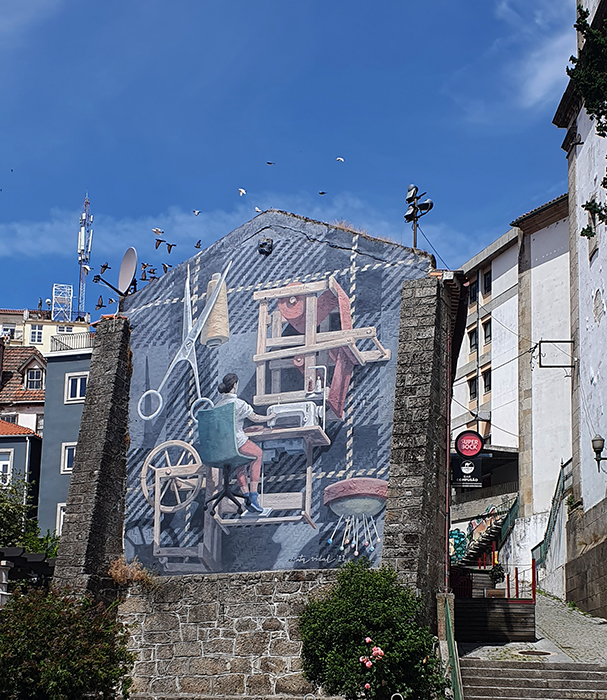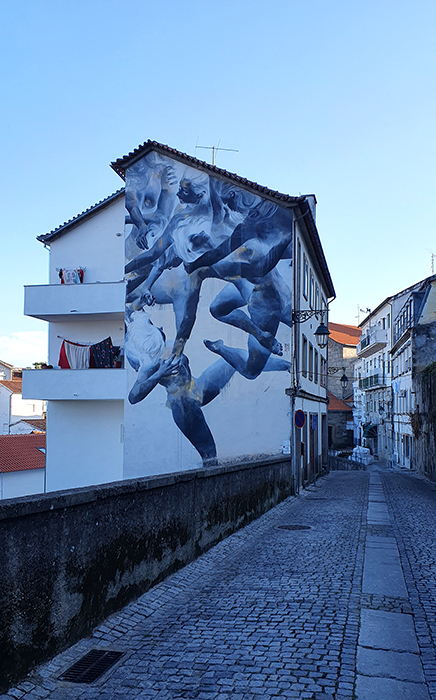Nestled beside Portugal’s highest mountains, Covilhã was once famed for its textile industry. Today, it is celebrated for the WOOL Festival, Portugal’s first urban art festival, launched in 2011. This festival promotes urban art as a means of fostering social, cultural, and economic transformation.
Thanks to the efforts of founders Lara, Pedro, and Elizabet, who excel at conveying the area’s identity to invited artists, every mural in Covilhã tells a story about the city—its history, culture, people, and landscape. This is significant for visitors, who gain insights about the city through its murals, and for residents, who see their sense of identity and pride reflected in the public art.
The community plays an integral role in the festival, participating in various activities from helping artists brainstorm themes with local knowledge to engaging in events during the festival days. This involvement has fostered a strong sense of identity and belonging among residents, who have embraced the murals as representations of their cultural legacy, often guiding visitors or sharing anecdotes.
The project aims to breathe new life into the public spaces of the historic city center by creating several routes that offer a new way to explore and experience the city. And this was exactly what I did during a weekend in Covilhã: an in-depth exploration of a Portuguese city that is often overlooked but truly deserves a visit.
WOOL Festival: Murals About Textile Tradition
Let’s start with the first mural produced by WOOL in 2011, when they invited the Portuguese duo Arm Collective to Covilhã. Blending different styles and techniques, this piece spans four facades of a building next to Santa Maria Church, mirroring its colors and composition. On the left, it features a shepherd with a ball of wool for a head, carrying a three-headed sheep. On the right, an Asian-looking worker is depicted carrying the weight of the city, represented as a factory, on his shoulders. This mural captures various themes that were felt particularly urgent at that time, from Dolly the sheep’s cloning to the decentralization of manufacturing.
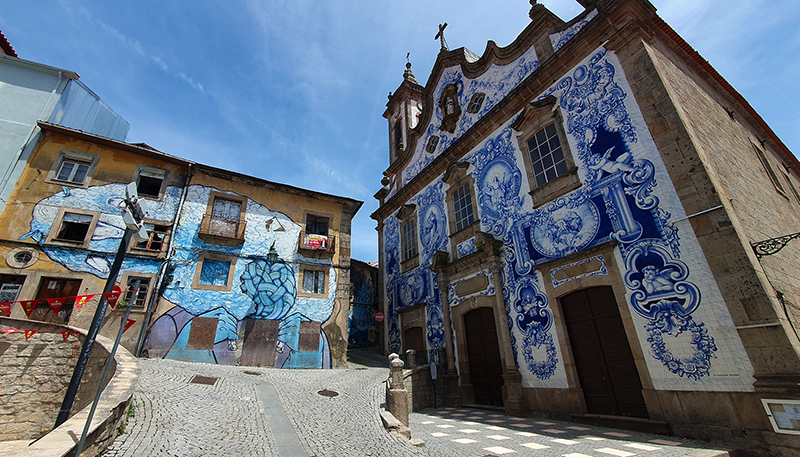
The ubiquitous sheep, an unofficial symbol of the city, appears in many artworks. These range from Catarina Glam‘s wooden installations inside blind windows and doors to the 2014 mural “Oddments” by Addfuel, in which the Portuguese artist combines his iconic reinterpretations of azulejos tiles with traditional local textile patterns.
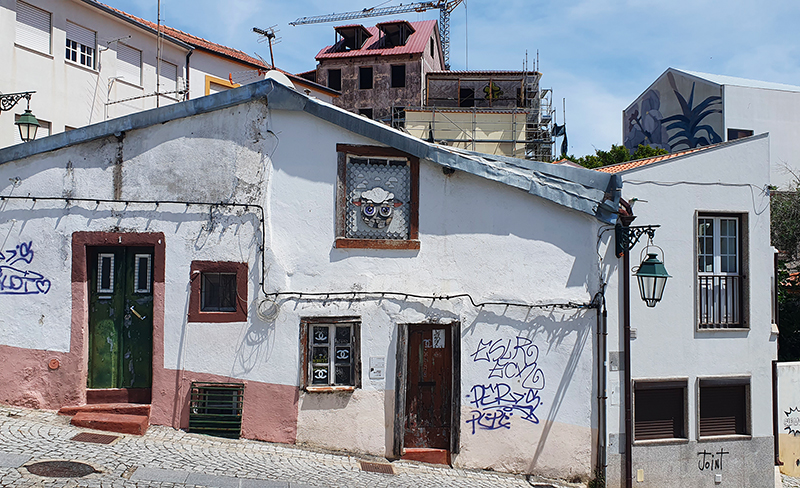
The textile heritage is symbolized in several murals around the city.
In 2024, Italian artist Millo painted a mural depicting a peace process, symbolized by a handshake from the iconic photo of Arafat and Rabin. This process is represented as a thread woven into fabric, highlighting the patience and effort involved. The traditional wooden shuttle, displayed in the city museum, represents this back-and-forth process.
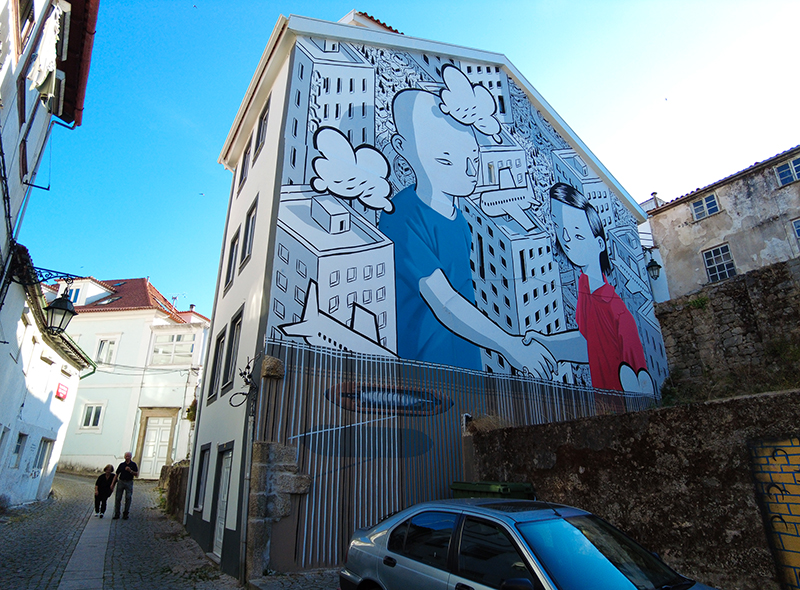
In 2023, English artist Helen Bur created the mural “Weight,” featuring a mountain of clothes and textiles loaded onto a woman’s shoulders. She carries this burden in the same pose as the statue of Atlas holding up the world, symbolizing the often overwhelming responsibilities shouldered by women, the quintessential caregivers. This intimate scene resonates globally, echoing the experiences of women across generations.
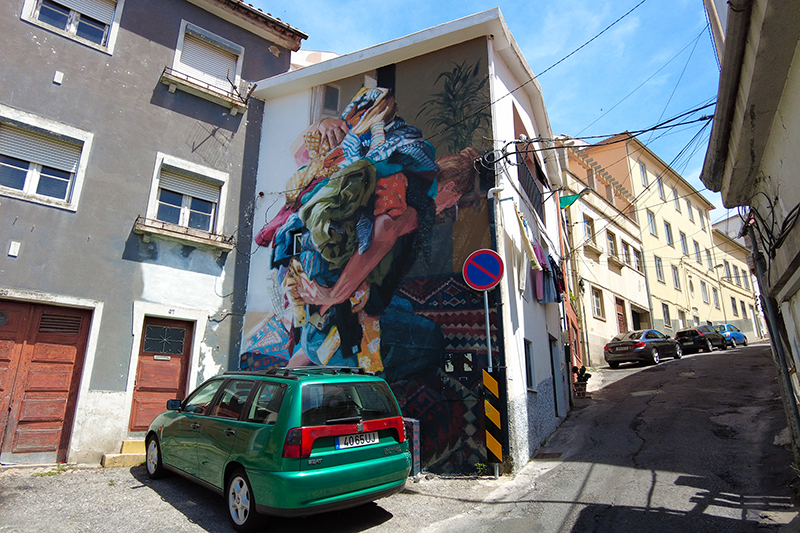
- Read also: “Catching up with Helen Bur at Nuart Aberdeen“
Tamara Alves painted a girl sewing her own bodice with threads emerging from her body, paying homage to artisanal craft and its potential disappearance, while Spanish artist Marta Lapeña collected objects emblematic of the region, including characteristic flowers, thistles, and an archival image of a young girl at a spinning machine, honoring the textile industry workers.
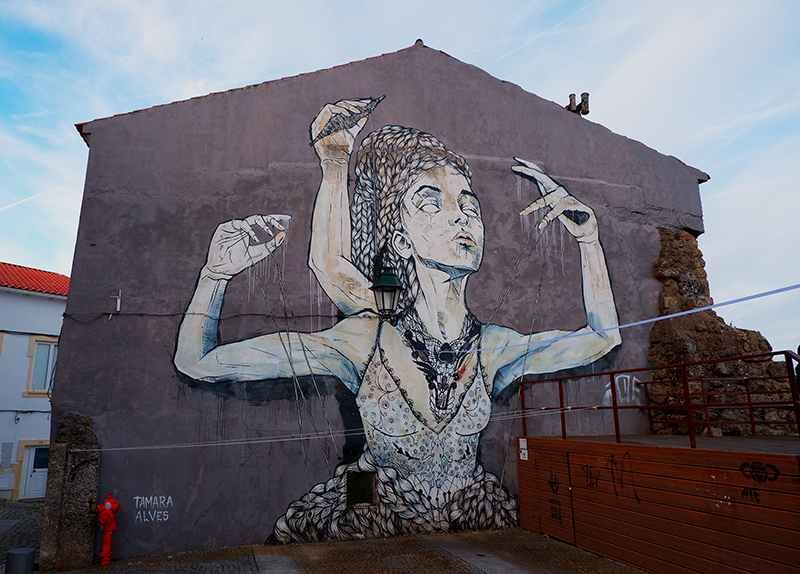
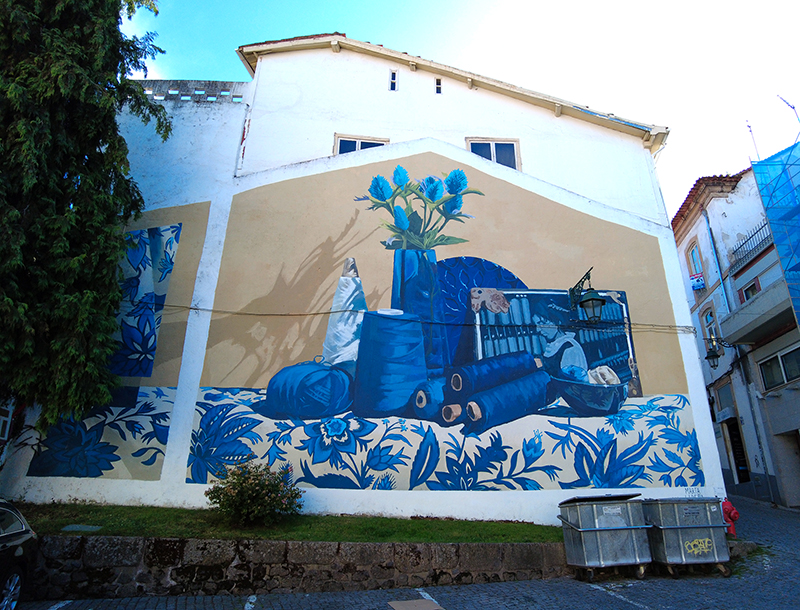
Many murals in Covilhã, including those by Regg Salgado, Cinta Vidal, Daniel Eime, and Taxis, are dedicated to women working in the textile industry.
Let’s take a closer look!
WOOL Festival: Murals About the Local Economy
In “Fio Condutor,” Portuguese artist Regg Salgado depicted the hands of a “metedeira de fios” (yarn mender), a job involving the manual repair of threads coming out of the weave, a technical defect in wool processing. Traditionally, this work was done by women at home, but I had the chance to see it performed during our visit to Fabrica Burel (highly recommended, btw!)
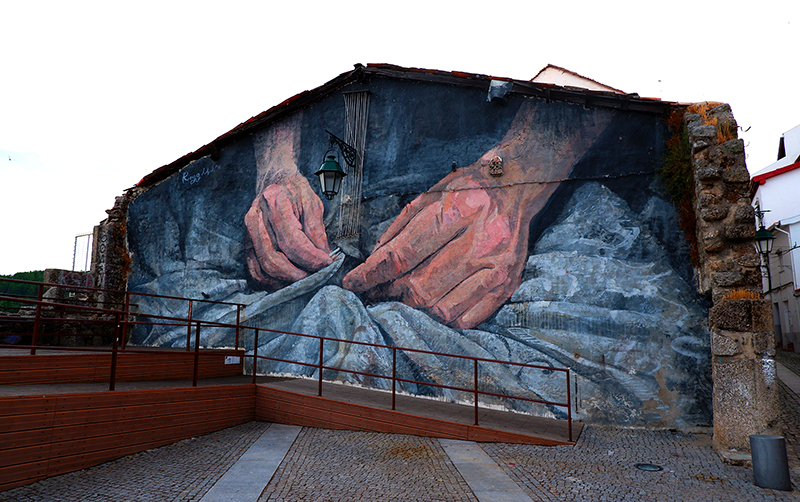
Additional tributes to women in the textile industry are found in murals by Portuguese stencil artist Daniel Eime, whose highly detailed work is inspired by an old photo taken in a factory, and Spanish artist Cinta Vidal, known for her play with perspective, gravity, and architectural elements.
During a visit to the city museum (highly recommended, as well!), I learned that the textile industry remains the primary economic driver of the region. This is vividly depicted in a mural by Portuguese artist Third, which integrates various mechanical elements of looms and other machinery from the Wool Factory Museum, along with a heart symbolizing the region’s economic lifeblood and a clock referencing factory work shifts.
Despite its current prominence, the textile industry faced a significant decline in the 1970s and 1980s, leading to the simultaneous closure of many local factories. This crisis resulted in economic hardship for numerous worker families and a profound social instability within the community. This sense of loss and instability is masterfully captured in the 2017 mural “Arrebatamento” by Argentine artist Bosoletti. Painted in his signature “negative” style, symbolizing the often pessimistic view of life, the mural portrays the social collapse following the factory closures. The composition was created from photographs Bosoletti took of the city’s ballet dancers.
Beyond the textile industry, another once-thriving sector was the local tungsten mining. This history was reinterpreted in the installations by Spanish artist Isaac Cordal, known for his tiny men placed in overlooked corners of cities as part of his Acid Collapse project. For Covilhã, Cordal created a site-specific project, a departure from his usual work, thanks to the curatorial efforts of the WOOL team. The result was a series of new installations around the city, reflecting its mining past.
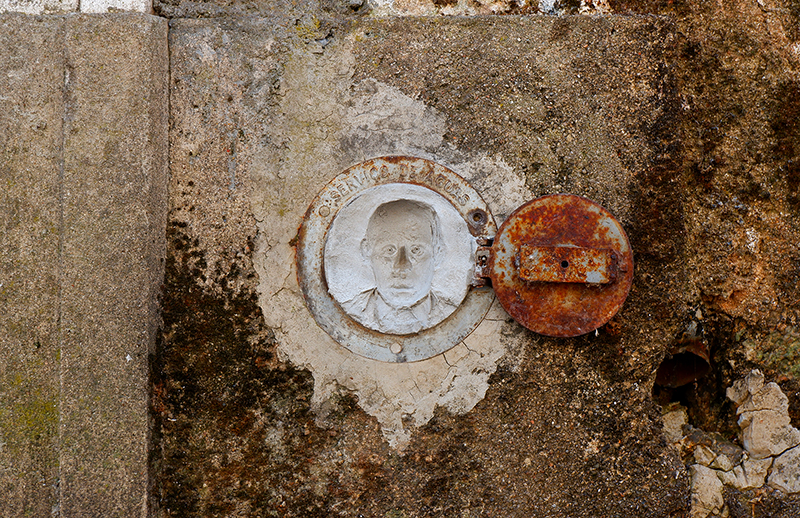
Addressing mining from a different angle, Reskate‘s 2022 mural explores the resurgence of mining in the area, this time for lithium, crucial for battery production. The Spanish duo combined graphic design and art to highlight the negative impacts of lithium mining, such as environmental pollution, agricultural damage, and compromised tourism. Their work underscores the message that “not all that glitters is gold,” with lithium being the “white gold.”
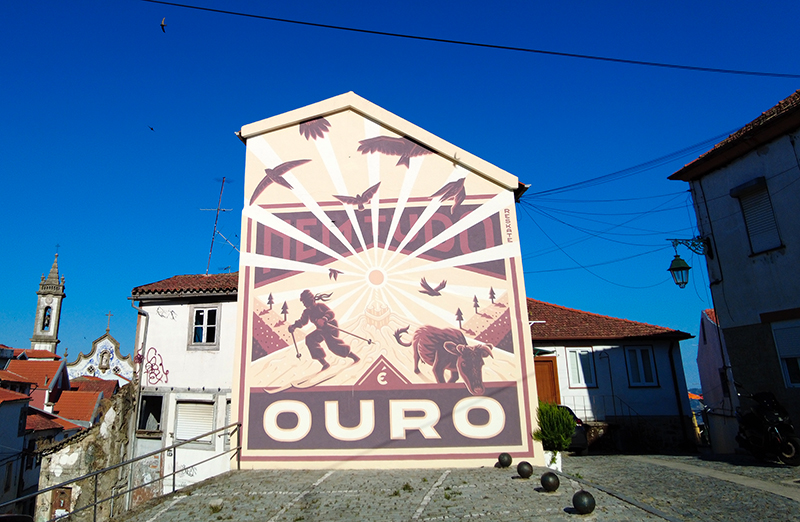
This bittersweet view of economic progress is also present in Taxis’ mural, especially in the expression of this young girl who has just started working at a local textile factory. Her gaze reflects a mix of pride in her new job and the realization that she must leave behind the carefree days of childhood. The background features the mountains of the Serra da Estrela Natural Park (yet another highly recommended visit!), and the statue on the right represents the city’s patron saint, Nossa Senhora da Conceição. Additionally, a vintage car alludes to the classic car races held on the mountain’s winding roads.
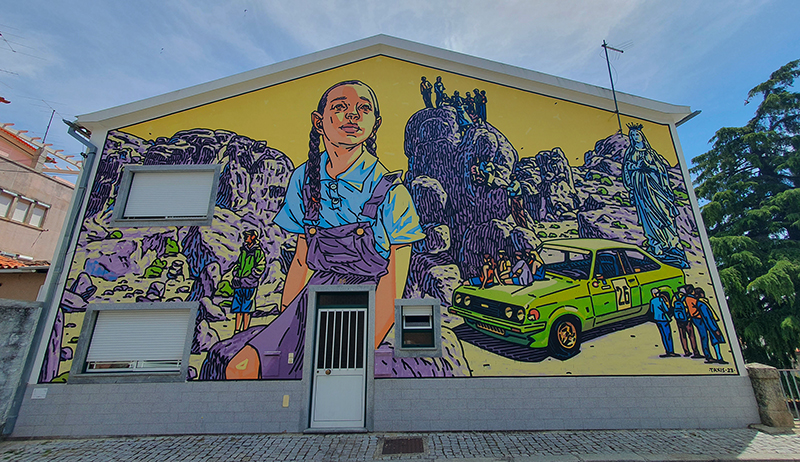
WOOL Festival: Covilhã Street Art Map
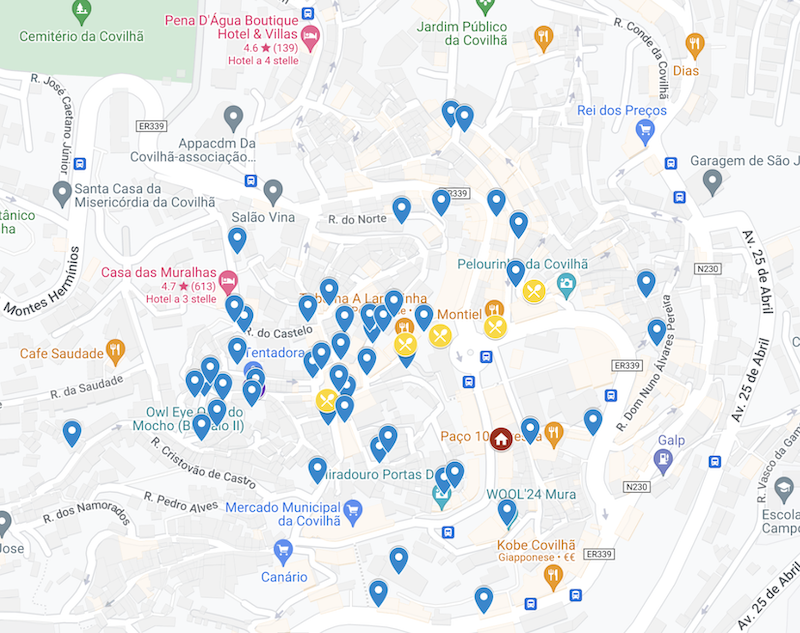
WOOL Festival: Murals About Local People
Nestled next to Portugal’s highest peak, Covilhã is well-known for hiking and skiing. In 2022, the Portuguese collective Ruído painted “A Serra e a Neve,” a collage combining old photos of one of the first ski competitions in Serra da Estrela with vintage posters and graphics promoting the area as a winter destination.
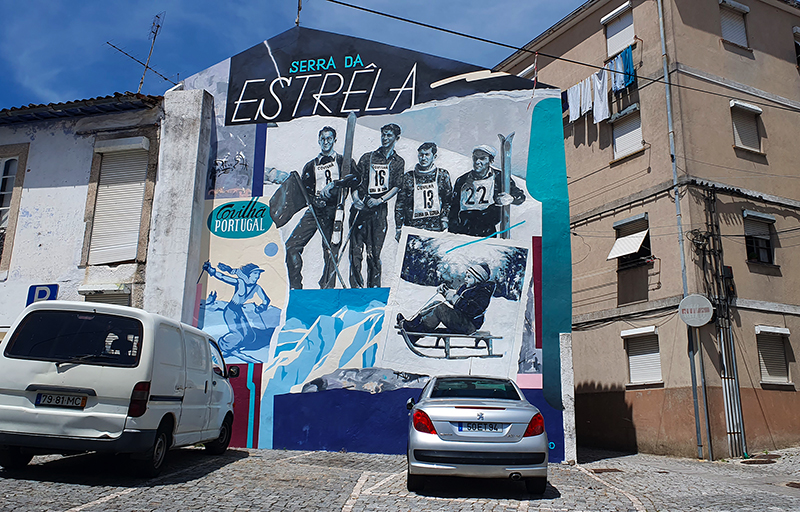
Continuing with the theme of local athletes, Mariana Duarte Santos’ mural “100 anos de Leões da Serra” captures the local football team’s glory days in Major League, highlighting the community’s collective memory and heritage. This mural is a collage of old newspapers celebrating the team, known as “the lions from the mountain.” Both the photos and the trophy depicted in the mural are housed in the city museum, which I recommend you visit!
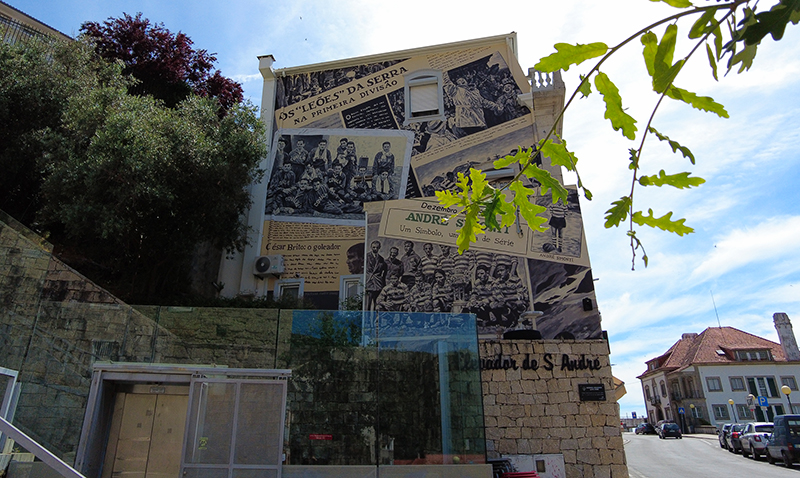
Still represented in the city museum is José Vizinho, the 16th-century engineer from Covilhã who invented the astrolabe. This instrument is depicted in Douglas Pereira‘s mural “O Observatório,” on the university wall. The vibrant mural, with its bold colors and intricate details, portrays young people studying, reading, and exploring with binoculars, symbolizing curiosity and the thirst for knowledge.
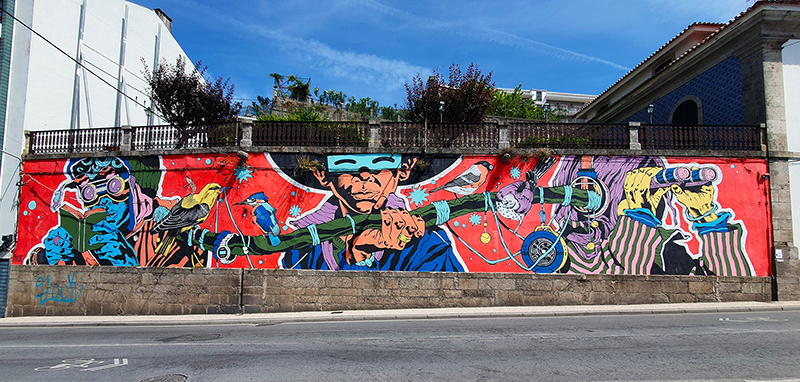
Another notable figure portrayed on the walls of the city is the visual poet Ernesto de Melo e Castro, honored by Frederico Draw in one of his characteristic portraits, in which he uses the spraycan as if it were charcoal.
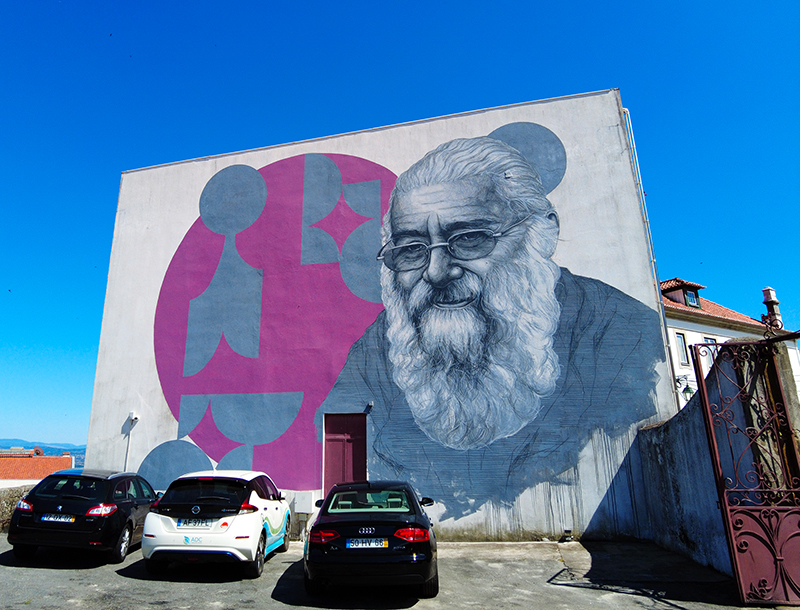
Around the streets of Covilhã, impressive portraits of local people by various artists can be found. Samina paid tribute to a local man, Sr. Viseu, who worked at the textile factory for 45 years. Sebas Velasco portrayed a local girl named Ananda and a local auto repair shop. Tiago Galo depicted the Covilhã music band, and Roc Blackblock honored the local firefighters who protect the beautiful natural park surrounding the city.
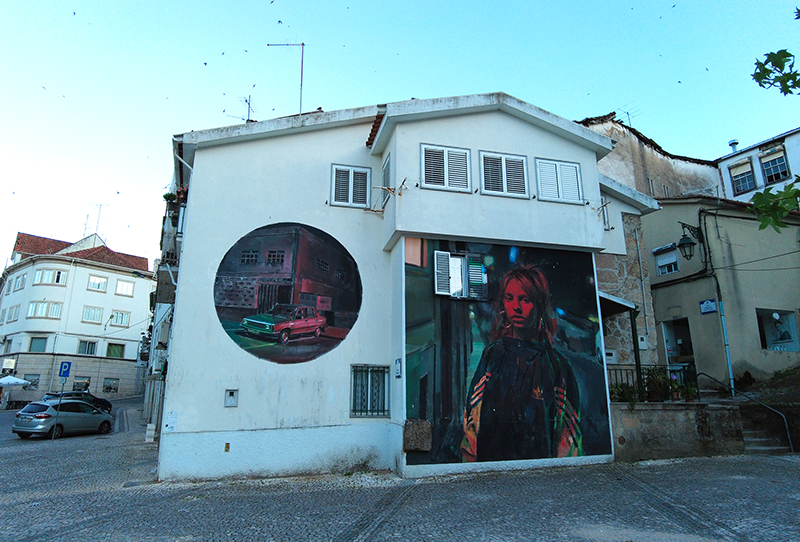
More portraits of local people are created with a personal touch. Spanish artist Alberto Monte’s black-and-white mural deconstructs an old photo of locals at a farmer’s market. Meanwhile, Jofre Oliveras aimed to represent a family as a tribal group, creating an anthropological study of different generations depicted in the style of colonial-era photographs of indigenous people, seen as “the weird ones.” This approach offers a historical perspective on power and colonialism in Portugal. Beyond the subjects depicted, the mural and its creation process reveal much about the inhabitants of Covilhã. Jofre aimed to shock and provoke strong reactions, but the locals accepted the person in drag and the overall subject of the mural with ease.
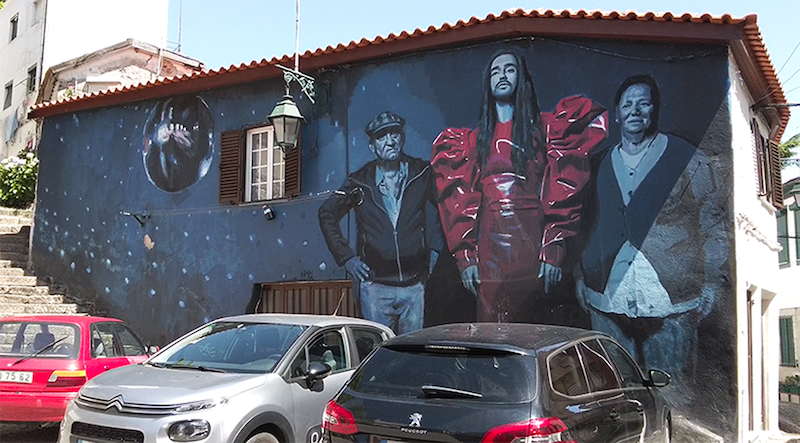
Special mention goes to murals depicting the mountain shepherds, who are both locals and symbolic figures. Besides the work by Arm Collective that initiated the Wool Festival, shepherds are central to creations by Belgian artist Gijs Vanhee, Portuguese artist TheCaver, and the Uruguayan duo Colectivo Licuado. Their mural “Expedição à Serra da Estrela” recounts the historical event of the first scientific expedition to Serra da Estrela in 1881, when the lost scientists were guided to safety by local shepherds, highlighting their crucial role in navigating the inhospitable terrain.
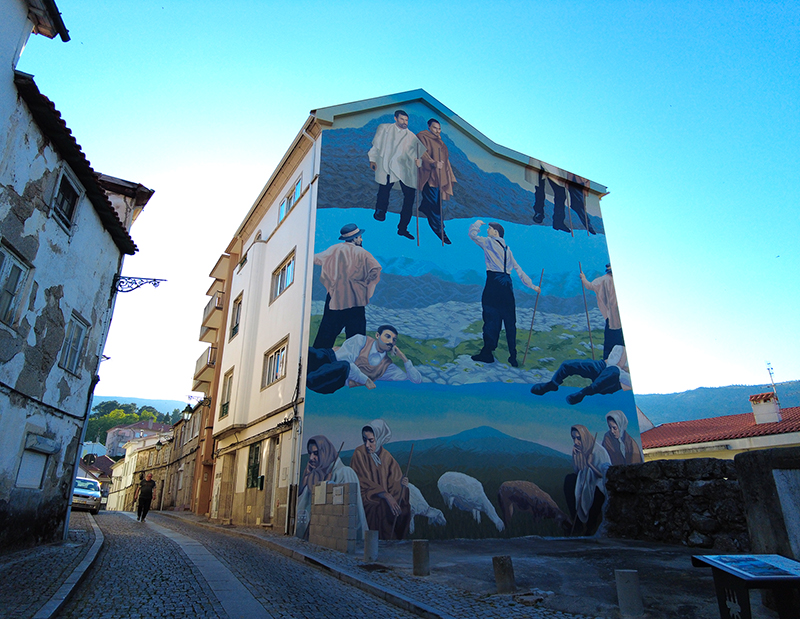
WOOL Festival: Murals About Local Flora and Fauna
The mountains and the natural species inhabiting them are the protagonists of many murals produced by the Wool Festival over the years.
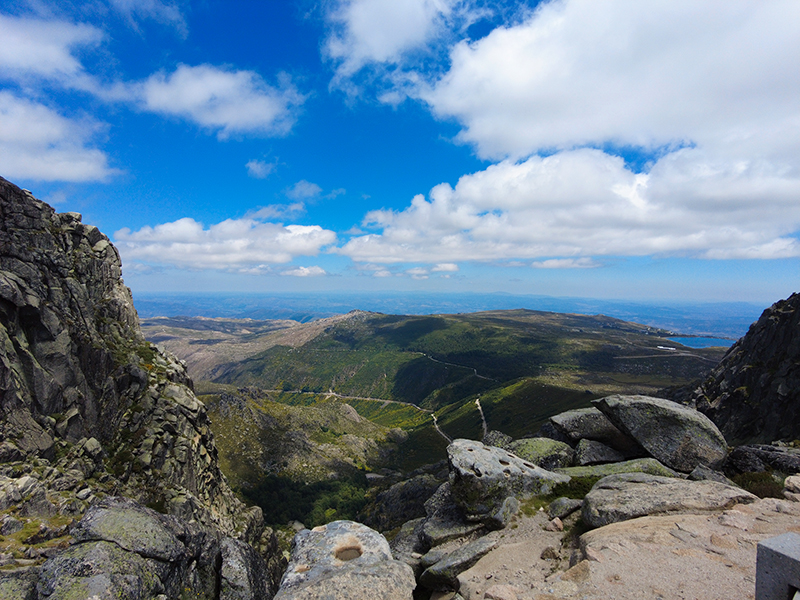
In 2015, Pantónio created one of his dynamic compositions, drawing inspiration from the birds (locally known as “andoriscos”) that seasonally cross the city’s sky.
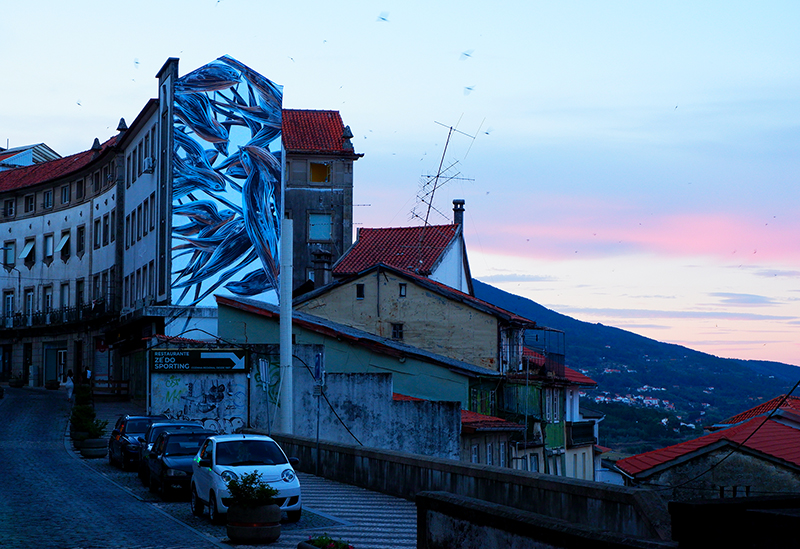
Other artists were inspired by the local plants and flowers. Pastel painted a small flower he found growing in the cracks of a wall in Covilhã, while Brazilian artist Mura depicted a local flower from the gentiana family, found only in the surrounding Serra da Estrela natural park, and therefore a protected species.
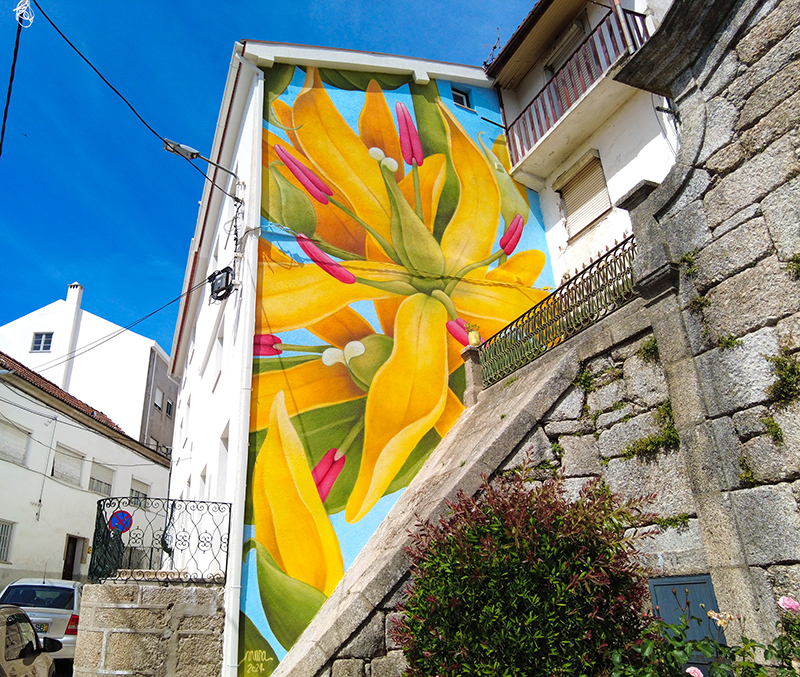
Doa Oa painted two typical plants used for dyeing military uniforms, with the left mural showing the plant used for blue dye and the right mural showing the one used for yellow dye. Covilhã held the monopoly on creating army uniforms, which were dyed using these two flowers. This mural is part of a series by the Spanish artist dedicated to “rewilding,” aiming to transform public spaces and revive them through plant-themed murals, raising awareness of the importance of the plant world and respect for it.
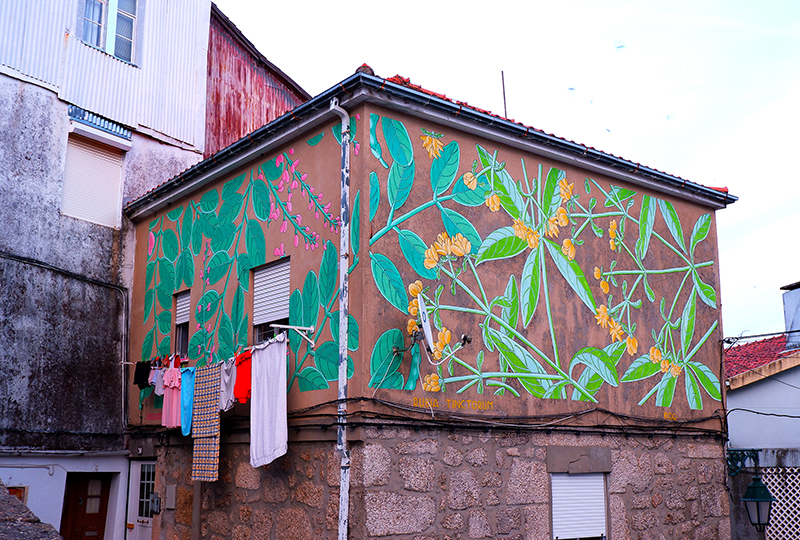
Portuguese artist Tiago Hesp reflected on the enormous rock that is the mountain near the village. This rock, though heavy, allows locals to reach great heights, step by step. The architectural structure of the city is shaped by constant climbing up and going down. By depicting the climb, the artist wanted to honor the ancestors who scaled the mountain and accepted for themselves and their children a balance between sweat and opportunity, between wealth and hard work.
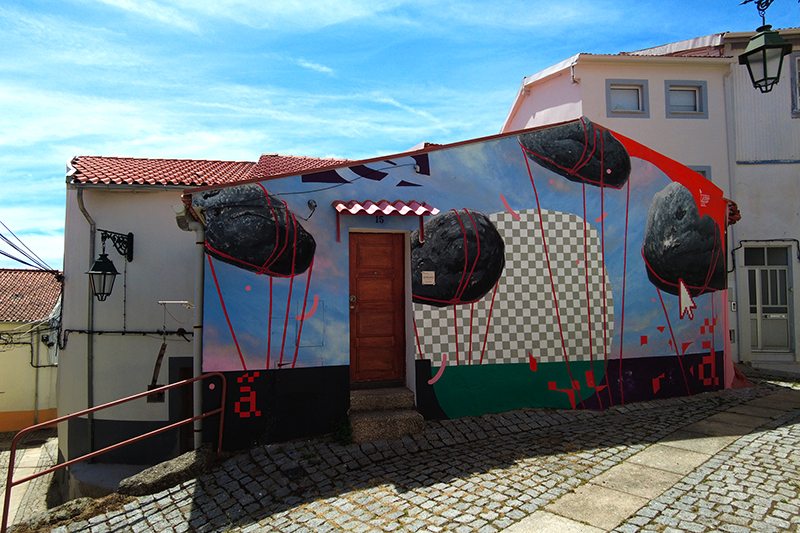
Finally, Spanish artist SpY offered a unique perspective on the landscape surrounding Covilhã with his installation: a super-sized replica of WWII’s Czech hedgehogs. This brutal anti-tank structure starkly contrasts with the rural scenery just outside the city. A similar juxtaposition is evident on the way to SpY’s installation, where the road passes through fields of black solar panels. These solar panel fields, which have replaced the agricultural fields of the past, present a decidedly less appealing aesthetic.
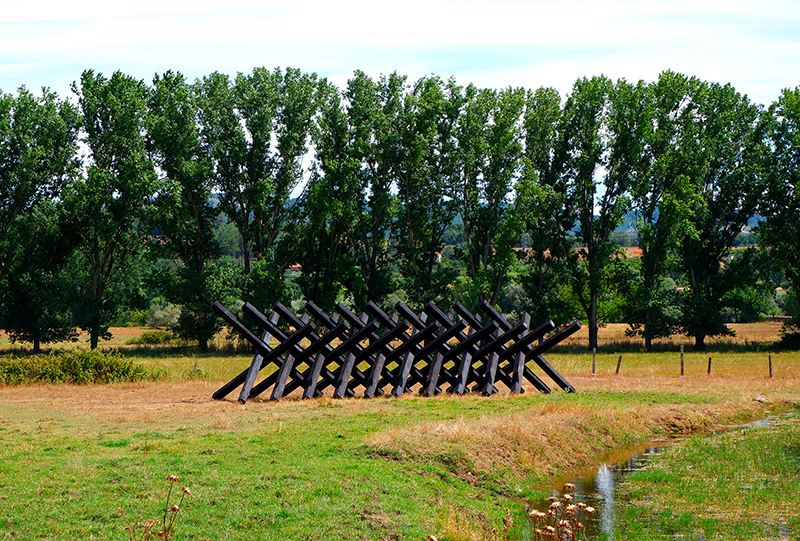
WOOL Festival: Murals About the City
More murals were inspired by Covilhã’s architecture and landmarks. In 2019, Kruella d’Enfer depicted the Manueline window of Casa da Hera, through which the Serra da Estrela mountain can be seen under an impressive starry sky. The mural also includes other local symbols like balls of wool and acorns. Nearby, Portuguese artist Francis.co painted the city’s industrial heritage, highlighting the factories and industrial architecture that characterize Covilhã.
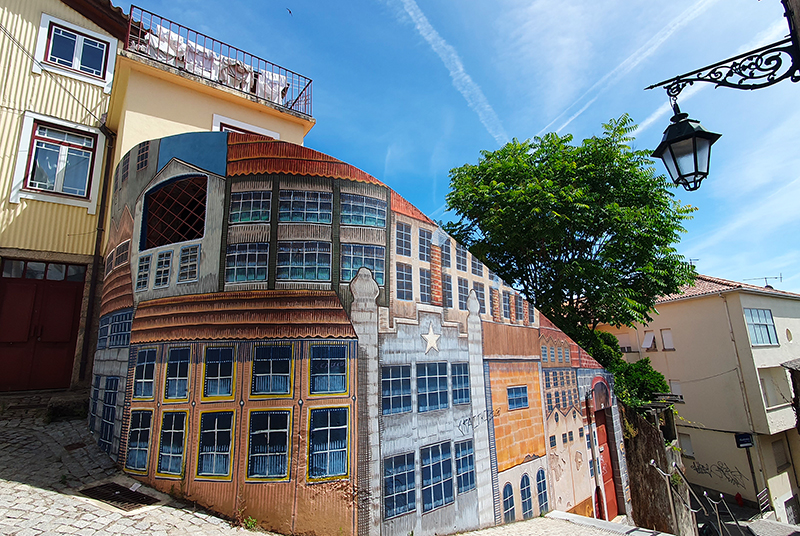
The city’s landmarks, such as the pedestrian bridge built in 2009 (which locals nicknamed “Portugal’s sexiest bridge”) and the ubiquitous factories and industrial buildings, are also featured in Pitanga‘s mural. This piece was based on ideas suggested by the children of the school where the mural is located, who were invited to reflect on the theme of a sustainable and green city. Nearby, Portuguese and Polish collective MOTS painted on the walls of a well-known tavern called “Parrot” tavern, famous for a parrot that constantly asked customers, “Have you paid?” and swore frequently, becoming a city icon.
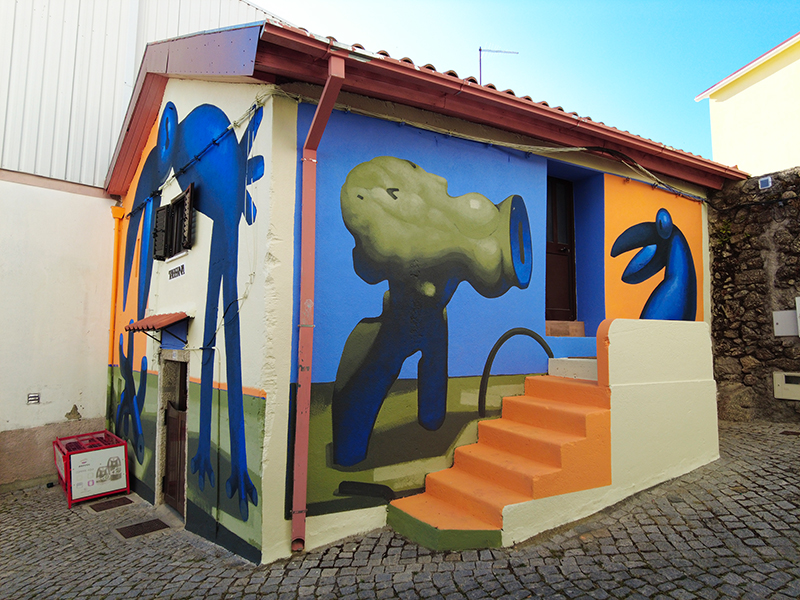
Another landmark, the 19th-century monumental fountain “Fonte das 3 Bicas,” is incorporated into Mário Belém‘s multi-layered piece with a water-themed narrative. This artwork features three characters representing three generations and their respective dreams: a child dreaming of flying, an adult working to achieve their dreams, and an elderly person who has spent their entire life in this mountainous area dreaming of seeing the sea.
The design studio Halfstudio created a diptych inspired by the fado song by Amalia Rodrigues, “Covilhã, cidade neve,” with murals reading “Cidade flor” (left) and “Em ti mora o meu amor” (right), while the diptych painted by Portuguese artist Daniela Guerreiro represents the tea ceremony to illustrate the long-standing trade relations between this region and England.
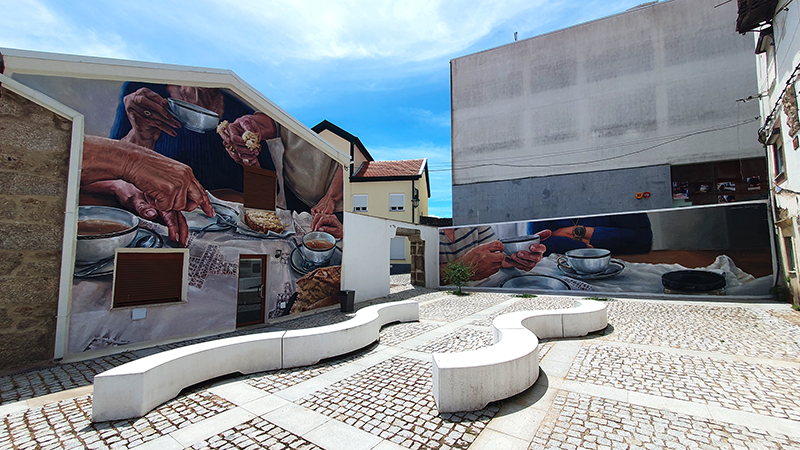
±MaisMenos± played with the name of the city, turning it into “Covil” (den), creating a political and economic message (“Covilhã das luvas bracas”, meaning “den of white gloves”), while Bordalo II chose to represent the owl, a symbol of knowledge, as a call for the revival of these values in the historic center, urging their preservation and care. Created in 2014, this was the first large-scale trash animal by the Portuguese street artist, marking his entry into the international art market and his consequent worldwide fame.

- Read also: “Behind the Scenes of Bordalo II’s mural in Rome“
More to Explore in Covilhã: Discover Portugal Beyond the Tourist Path
Besides the murals, there is much more to see in Covilhã and its surrounding areas. Begin with the stunning Serra da Estrela Natural Park, home to the highest peak in Portugal, where you can experience breathtaking views above the clouds.
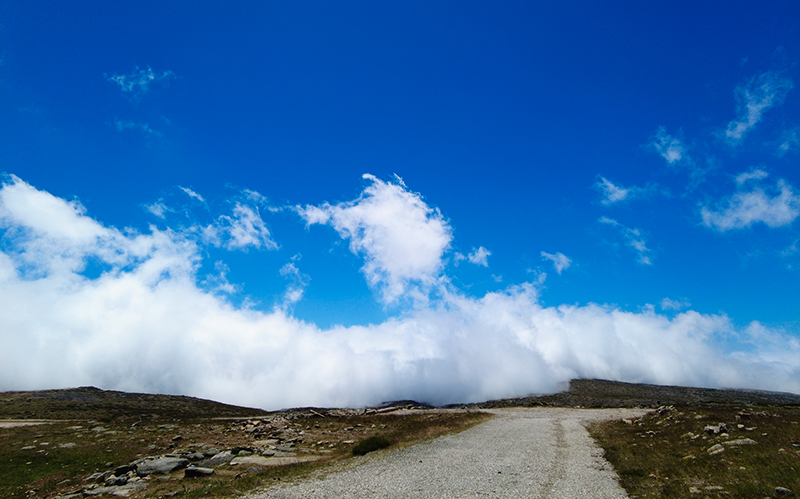
On your way to the mountain, make sure to stop at Burel Factory, one of the two remaining textile factories in the area. The factory welcomes visitors and features a fantastic shop selling unique designs crafted from locally produced wool.
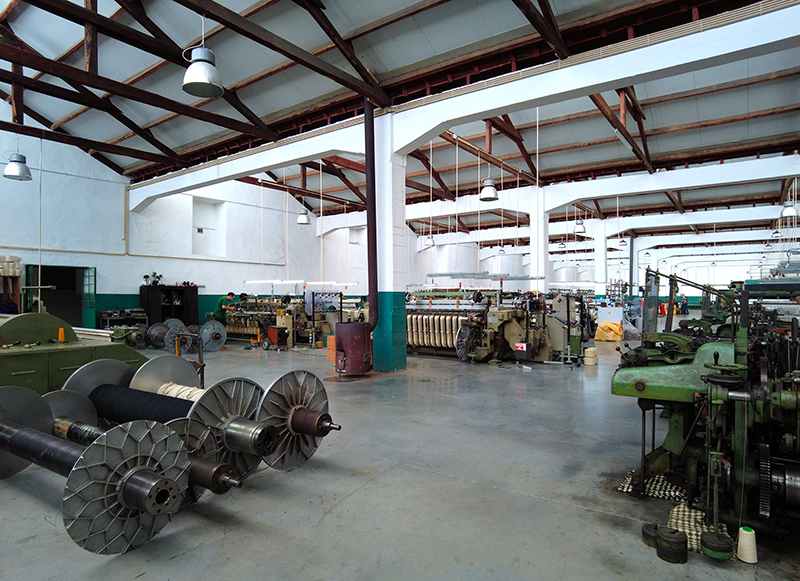
In the city, the Covilhã Museum is a must-visit. It offers an interactive journey through the city’s history, from its Roman origins to the present day.

Another highlight in Covilhã is A Tentadora, the charming shop that also serves as the headquarters for the Wool Festival. Housed in an old shop that retains all its original furniture, A Tentadora displays vintage objects and designs. Pedro, one of the co-founders of the Wool Festival, is an avid collector of old signs, objects, and various artifacts. The shop features these vintage items alongside gadgets produced in the area and the official festival merchandise, making it a delightful stop for anyone interested in local culture and design.
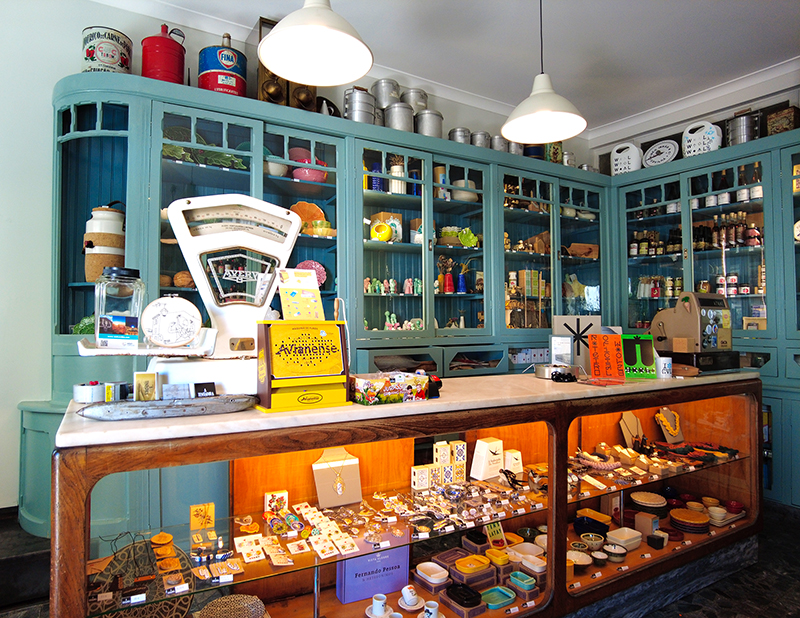
These attractions, along with the excellent urban art, make Covilhã an unforgettable destination. I found myself captivated by the city’s rich history, fascinated by its textile legacy, and refreshed by the breathtaking natural landscapes. The typical Portuguese streetscapes, bathed in a unique light, enchanted me and seemed to make everything glow. The city’s culinary scene is also a highlight, especially the irresistible nata pastries.
What fascinated me the most, however, was the incredible industrial heritage of the city, both repurposed and abandoned. Exploring Covilhã, I stumbled upon numerous deserted factories that stand as silent witnesses to the city’s industrial past, adding an intriguing touch of urbex to my visit.
Covilhã is truly a hidden gem, and I can’t wait to return next year to experience the Wool Festival firsthand, witnessing even more contextual murals come to life in this captivating city.
WOOL Festival: Murals Map

